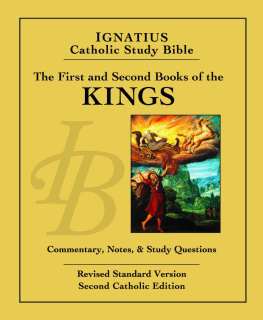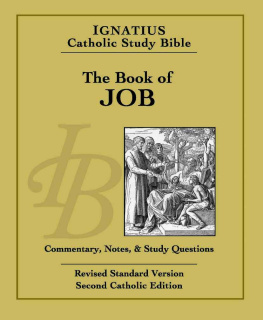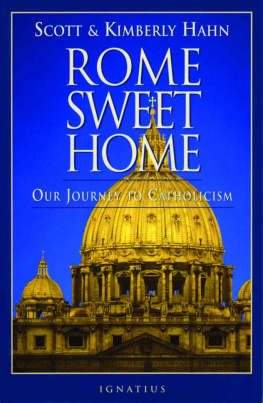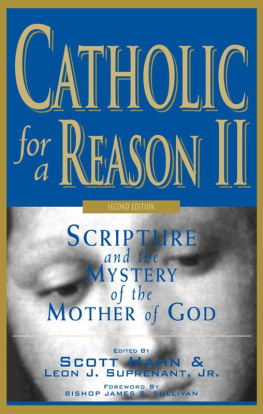




Scott Hahn







... 71

 od has spoken to us "in many and various ways" (Heb 1:1). He speaks to us in the wonders of creation; for he made all the universe through his eternal Word On 1:3). He speaks to us in the written story of creation and salvation that we find in the Bible - in the law, prophets, Gospel, and Apostles.
od has spoken to us "in many and various ways" (Heb 1:1). He speaks to us in the wonders of creation; for he made all the universe through his eternal Word On 1:3). He speaks to us in the written story of creation and salvation that we find in the Bible - in the law, prophets, Gospel, and Apostles.
Yet all these various strains harmonize perfectly in the person of the Word made flesh, Jesus Christ. In Jesus, God communicated himself completely. Yet even then he spoke to us in words. Jesus spoke, preached, counseled, taught, and prayed aloud. He asked questions. He told stories. He even traced words in the sand. He did all of this for our sake, because words are a normal human thing. Nevertheless, his words are extraordinary, because they are revelatory. They are human words that reveal the eternal Word of God. They are the Word of God in the words of men and women and children.
In the Bible, we encounter not a dead letter, but a person: the "Word of God ... living and active" (Heb 4:12). This is not a word we can manipulate or spin to suit our whims. It is Jesus Christ, who comes with a fearsome power over all the elements, over life and death. "His eyes are like a flame of fire, and on his head are many diadems ... He is clad in a robe dipped in blood, and the name by which he is called is The Word of God" (Rev 19:12-13).
He has come into our lives with that power, as our teacher, savior, brother, God. Let us welcome the Word of God, then, in the very words of God.



 he Bible is the Word of God in human words. Because it comes to us from Almighty God, it has the power to be life-transforming. For God knows each of us, and he knows what we need when we open up the book.
he Bible is the Word of God in human words. Because it comes to us from Almighty God, it has the power to be life-transforming. For God knows each of us, and he knows what we need when we open up the book.
Sometimes we find his Word thundering from above, sometimes whispering in a still, small voice, but always it is the Word sent by the All-Knowing, All-Loving, All-Powerful.
The Bible is a whole library of books written over the course of more than a thousand years, in many different styles, with many different points of view, by dozens of different writers.
But it is also one book, with one Author - God - telling one story: the heart-pounding, thrill-a-minute story of our salvation.
No other book has that kind of variety and unity, or unity-in-variety. It's what can make reading the Bible not just a pleasure, but one of the most exciting intellectual experiences of your life.
The story takes a long time to develop, and you'll meet many interesting characters along the way. By the end you'll realize that, from the very beginning, God always had a providential plan - a fatherly plan to save his children on earth. You'll also see how, like a master novelist, he sent people and events that foreshadowed later people and events, preparing his people for the greater things to come by giving them images that would help them understand.
Finally, there's one more thing that makes the Bible unique. You don't have to be satisfied with just reading it: you can step right into it. Wherever the sacraments are celebrated, they are the Bible in action. Reading the Bible helps prepare you for the sacraments, and in the sacraments everything you've read about comes to life right before your eyes.
Doesn't that sound like an adventure? Then let's get started.



 he Bible is a library of dozens of books. Like any good library, it has to be organized somehow, so that you can find the books you need.
he Bible is a library of dozens of books. Like any good library, it has to be organized somehow, so that you can find the books you need.
Since the Bible starts with the beginning of time and ends with the end of time, you might expect the books to be arranged chronologically. Actually, the arrangement is both more complicated and more logical than that.
The two big divisions, of course, are the Old Testament and the New Testament. The Old Testament is all the books of Scripture written before the coming of Jesus Christ; the New Testament is all the books of Scripture written after the coming of Jesus Christ.
A more basic question is: What is a "Testament"? Testament is an English translation of the Greek word diatheke, which can more accurately be translated as "covenant." In the ancient world, a covenant was a solemn agreement that estab lished a family bond between two parties - marriage and adoption, for example, were covenant relationships, as were international alliances. The Old Covenant and the New represent stages in God's relationship with his people.
In each of these two big divisions, the Old and the New, the books are arranged in groups according to type.
The Old Testament
There are four main divisions in the Old Testament:1. The Law. These are the five books of Moses, the foundation of everything else in the Old Testament. They tell the story of how Israel began and give rules for life and worship.2. History. These books tell the story of Israel in the Promised Land, from the conquest through the kingdom and the Exile to the successful rebellion of the Maccabees.3. Wisdom. These books include reflection on the order of creation as well as moral instruction on personal virtue, family life, governance, and fear of the Lord.4. Prophecy. The word of God: his judgment on the wicked and his promises of comfort to the afflicted.
The New Testament
When we look at the New Testament, we can see the same kind of four-part structure:1. The Gospels (the Law). The foundation of everything else in the New Testament, telling how Jesus Christ brought the New Law by which Christians live.2. The Acts of the Apostles (history). The founding and spread of the new kingdom the Church.3. Epistles (wisdom). Meditations on the meaning of Christian wisdom, and practical advice on living the Christian life.4. The Revelation (prophecy). How the final judgment brings punishment to the wicked and comfort to the afflicted.Just remembering those four big divisions in the two Testaments will be a great help in getting familiar with what's in the Bible. Once you know the broad organization, you'll be sur prised how quickly you can find just about anything you're looking for.
Next page
![Scott Hahn [Inconnu(e)] A Pocket Guide to the Bible](/uploads/posts/book/134750/thumbs/scott-hahn-inconnu-e-a-pocket-guide-to-the.jpg)




![Scott Hahn [Inconnu(e)] - Scripture Matters: Essays on Reading the Bible From the Heart of the Church](/uploads/posts/book/134760/thumbs/scott-hahn-inconnu-e-scripture-matters-essays.jpg)

![Scott Hahn [Inconnu(e)] - Letter and Spirit: From Written Text to Living Word in the Liturgy](/uploads/posts/book/134755/thumbs/scott-hahn-inconnu-e-letter-and-spirit-from.jpg)
![Scott Hahn [Inconnu(e)] - Lenten Reflections From a Father Who Keeps His Promises](/uploads/posts/book/134754/thumbs/scott-hahn-inconnu-e-lenten-reflections-from-a.jpg)

![Scott Hahn [Inconnu(e)] - A Father Who Keeps His Promise: God’s Covenant Love in Scripture](/uploads/posts/book/134748/thumbs/scott-hahn-inconnu-e-a-father-who-keeps-his.jpg)













 od has spoken to us "in many and various ways" (Heb 1:1). He speaks to us in the wonders of creation; for he made all the universe through his eternal Word On 1:3). He speaks to us in the written story of creation and salvation that we find in the Bible - in the law, prophets, Gospel, and Apostles.
od has spoken to us "in many and various ways" (Heb 1:1). He speaks to us in the wonders of creation; for he made all the universe through his eternal Word On 1:3). He speaks to us in the written story of creation and salvation that we find in the Bible - in the law, prophets, Gospel, and Apostles.


 he Bible is the Word of God in human words. Because it comes to us from Almighty God, it has the power to be life-transforming. For God knows each of us, and he knows what we need when we open up the book.
he Bible is the Word of God in human words. Because it comes to us from Almighty God, it has the power to be life-transforming. For God knows each of us, and he knows what we need when we open up the book.


 he Bible is a library of dozens of books. Like any good library, it has to be organized somehow, so that you can find the books you need.
he Bible is a library of dozens of books. Like any good library, it has to be organized somehow, so that you can find the books you need.